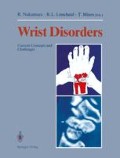Abstract
The relation between residual deformity in the fracture of the distal radius and the rotation of the forearm is reviewed clinically and experimentally.
The clinical study included 45 cases of closed fracture in patients aged 15 years and over. Assuming that the rotational range on the opposite side was 100%, the average range of pronation-supination was 92.3%. The rotational ranges in the operated cases and in the fracture involving the distal radioulnar (DRU) joint were unsatisfactory. The incidence of symptomatic complaints was high in the cases with a rotational range of under 92%. There was no difference between the rotational range and the radiologically confirmed residual deformity.
Experimentally, we used 4 human upper-extremity cadaver specimens leaving the joint capsule and the interosseous membrane. After making extra-articular fractures, we measured the rotational range and the radiological angle of tilt for each fracture. Experimental results showed that the rotatory range decreased with each change of the angle of tilt.
We consider that the soft tissue problems caused the rotational disturbance in the operated cases because the fractures upon which we operated had severe displacement or comminution. It may be that the loss of rotation in the experiment was related to maladaptation in the DRU joint and change of tension of the soft tissue around the joint. However, this cannot explain the rotational disturbance in relation to the angle of tilt. We must be careful to provide a good alignment of the DRU joint at reduction procedure in order to prevent rotatory disturbance.
Access this chapter
Tax calculation will be finalised at checkout
Purchases are for personal use only
Preview
Unable to display preview. Download preview PDF.
References
Frykman G (1967) Fracture of the distal radius including sequelae — shoulder-hand-finger syndrome, disturbance in the distal radio-ulnar joint and impairment of nerve function. A clinical and experimental study. Acta Orthop Scand Suppl 108
Patrick J (1946) A study of supination and pronation, with especial reference to the treatment of forearm fractures. J Bone Joint Surg [Am] 28:737–748
Gartland JJ, Werley CW (1951) Evaluation of healed Colles’ fractures. J Bone Joint Surg [Am] 33:895–907
Author information
Authors and Affiliations
Editor information
Editors and Affiliations
Rights and permissions
Copyright information
© 1992 Springer-Verlag Tokyo
About this paper
Cite this paper
Munesada, S., Oka, Y., Terada, H., Rokuuma, N. (1992). Rotation of the Forearm in Fracture of the Distal Radius: Clinical and Experimental Studies. In: Nakamura, R., Linscheid, R.L., Miura, T. (eds) Wrist Disorders. Springer, Tokyo. https://doi.org/10.1007/978-4-431-65874-0_27
Download citation
DOI: https://doi.org/10.1007/978-4-431-65874-0_27
Publisher Name: Springer, Tokyo
Print ISBN: 978-4-431-65876-4
Online ISBN: 978-4-431-65874-0
eBook Packages: Springer Book Archive

